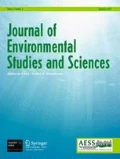Erratum to: J Environ Stud Sci (2013) 3:359–368
DOI 10.1007/s13412-013-0140-1
After this paper was published, the authors discovered that data for 5 of the 29 students compared in Fig. 4 on page 364 had not been processed using the same algorithm as the other 24 students. When data for all 29 students are calculated using the same and appropriate algorithm, there is no statistical difference between the pre- and post-program scores as indicated in Table 2 of the original paper. Figure 4 below provides the correct data. These modified results require a change in one of the conclusions highlighted in the abstract. In addition, the results are now consistent with a longer and more comprehensive assessment of the impact of engineering curriculum and pedagogy on the development of what Pistrui et al. (2012) describes as seven discriminating skills for engineers.
Although these results are no longer statistically significant, we are confident that our approach to the development of twenty-first century competencies can be done concomitantly with the intellectual growth, the development of content knowledge, and the ability to think about systems. This study documents the use of business-based instruments, such as the TriMetrix® DNA, as part of a formative program-assessment process that can lead to major curriculum modifications and the integration of pedagogical approaches and educational practices that further promote student independence, self-directed learning, and self-reliance.
Reference
Pistrui D, Layer JK, Dietrich S (2012) Mapping the behaviors, motives and professional competencies of entrepreneurially minded engineers in theory and practice: an empirical investigation. Proceedings American Society for Engineering Education 2012 Annual Conference, June 10–13, 2012, San Antonio, Texas
Author information
Authors and Affiliations
Corresponding author
Additional information
The online version of the original article can be found at http://dx.doi.org/10.1007/s13412-013-0140-1.
Rights and permissions
About this article
Cite this article
Gosselin, D., Cooper, S., Bonnstetter, R.J. et al. Erratum to: Exploring the assessment of twenty-first century professional competencies of undergraduate students in environmental studies through a business—academic partnership. J Environ Stud Sci 4, 188–189 (2014). https://doi.org/10.1007/s13412-014-0164-1
Published:
Issue Date:
DOI: https://doi.org/10.1007/s13412-014-0164-1


